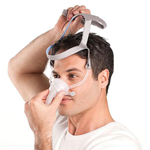
CPAP therapy has a lot of moving parts and can feel overwhelming for new (and even seasoned) users. When things aren’t working, it can be hard to figure out where exactly the problem might be. To help you out, we’ve come up with a list of the first things you should check when your therapy is not working properly, to get you back on track and sleeping soundly.
Mask Fit
One of the most common issues with CPAP therapy is mask fit – meaning maintaining an air-tight seal between the face and the mask. Even a tiny leak can cause major issues for CPAP users, so it is important to make sure you have a good seal with whichever mask you are using.
Leaks
![]() If the seal is leaking, the problem could be due to a few different things. A common issue is that the cushions should be replaced – the silicone does wear out over time and can’t hold its shape. This can cause leaks. Fit issues can also cause mask leaks – if the mask is not the correct size, the chances of it leaking are very high. This is why it is important to make sure to use the sizing guides and fitting guides available for most masks, to ensure that you are using the proper size for your face.
If the seal is leaking, the problem could be due to a few different things. A common issue is that the cushions should be replaced – the silicone does wear out over time and can’t hold its shape. This can cause leaks. Fit issues can also cause mask leaks – if the mask is not the correct size, the chances of it leaking are very high. This is why it is important to make sure to use the sizing guides and fitting guides available for most masks, to ensure that you are using the proper size for your face.
Worn-out Equipment
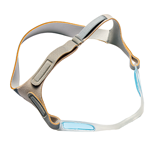 The cushions and pillows on the masks aren’t the only things that wear out. Headgear straps tend to lose their elasticity as well. These should ideally be replaced every six months. If the headgear straps have lost their elasticity, patients will tend to pull the straps too tight to get a good seal, which will cause marks on their face, which isn’t what you want to see in the mirror the next morning.
The cushions and pillows on the masks aren’t the only things that wear out. Headgear straps tend to lose their elasticity as well. These should ideally be replaced every six months. If the headgear straps have lost their elasticity, patients will tend to pull the straps too tight to get a good seal, which will cause marks on their face, which isn’t what you want to see in the mirror the next morning.
Bad Seal/ Mask Irritation
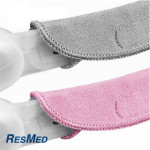 If you are still having trouble maintaining a good seal and you have checked that you have the right size, you have a fresh cushion, and your headgear is not worn out, then another option that can help is using a mask liner. Mask liners not only help with leaks and hygiene (because they are disposable), but they can also prevent marks on the face and increase comfort. If it’s the straps that bother you, try soft wraps to protect your skin and scalp.
If you are still having trouble maintaining a good seal and you have checked that you have the right size, you have a fresh cushion, and your headgear is not worn out, then another option that can help is using a mask liner. Mask liners not only help with leaks and hygiene (because they are disposable), but they can also prevent marks on the face and increase comfort. If it’s the straps that bother you, try soft wraps to protect your skin and scalp.
Your Tube
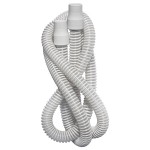 Tubes also wear out, especially near the ends and can easily tear if mishandled or well-used. If there is a hole in your tube, you may be able to temporarily patch it using some kind of tape, but your best bet is dehttps://blog.easybreathe.com/trouble-cpap-checklist/?preview=truefinitely to replace the tube. We recommend having an extra tube on-hand in case of situations like this, so that you do not find yourself stuck without your machine just because of a minor tube issue. If you are having trouble finding the hole in your tube but you suspect it is there, you can submerge the length of the tube in water (keeping the ends out) and blow through one end of the tube while covering the other end, watching for any bubbles that exit anywhere along the length of the tube underwater. This will tell you where the holes are.
Tubes also wear out, especially near the ends and can easily tear if mishandled or well-used. If there is a hole in your tube, you may be able to temporarily patch it using some kind of tape, but your best bet is dehttps://blog.easybreathe.com/trouble-cpap-checklist/?preview=truefinitely to replace the tube. We recommend having an extra tube on-hand in case of situations like this, so that you do not find yourself stuck without your machine just because of a minor tube issue. If you are having trouble finding the hole in your tube but you suspect it is there, you can submerge the length of the tube in water (keeping the ends out) and blow through one end of the tube while covering the other end, watching for any bubbles that exit anywhere along the length of the tube underwater. This will tell you where the holes are.
Machine Settings
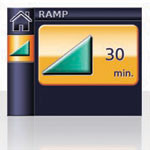 On auto-titrating machines you must have your CPAP machine set to the correct type of mask. If your machine seems to be blowing way too hard or not enough, this could be the problem. Also, keep in mind that the ramp setting is adjustable. The ramp feature will gradually ramp up the pressure to reach your optimum pressure. The time you set should match the time you take to fall asleep. Also, keep in mind that if you are concerned because the machine does not seem to have much pressure when you first put it on, but you seem to be sleeping fine, this can be why.
On auto-titrating machines you must have your CPAP machine set to the correct type of mask. If your machine seems to be blowing way too hard or not enough, this could be the problem. Also, keep in mind that the ramp setting is adjustable. The ramp feature will gradually ramp up the pressure to reach your optimum pressure. The time you set should match the time you take to fall asleep. Also, keep in mind that if you are concerned because the machine does not seem to have much pressure when you first put it on, but you seem to be sleeping fine, this can be why.



